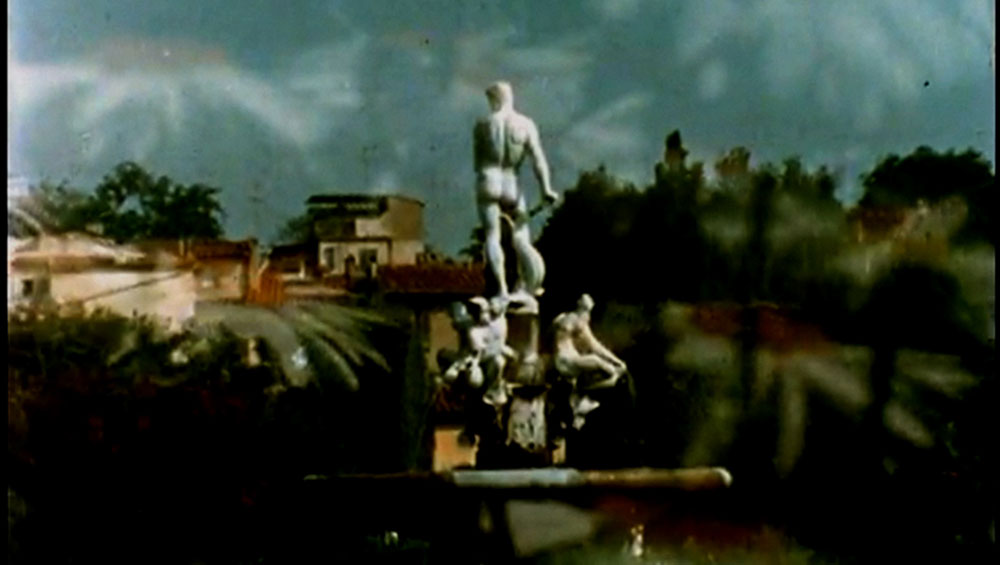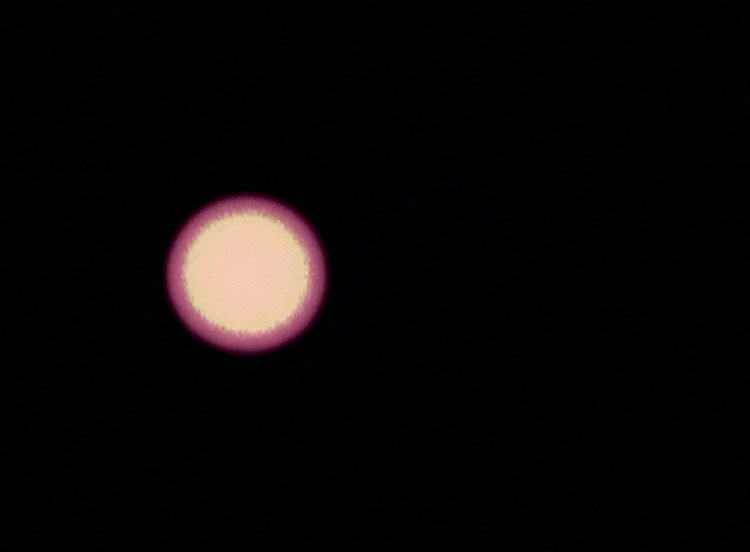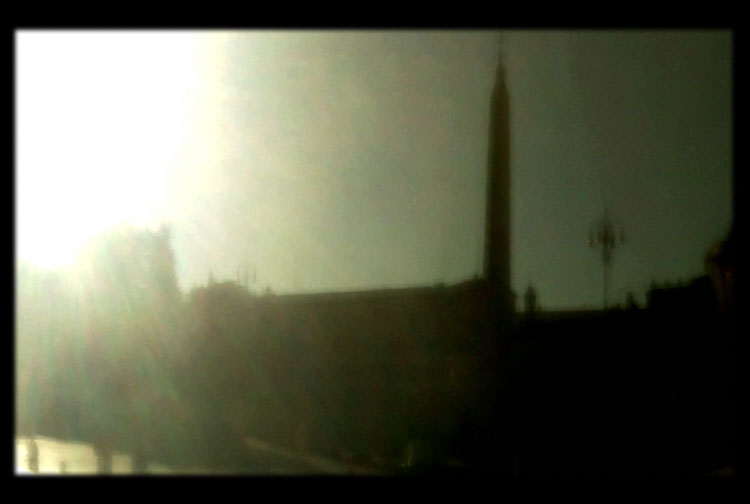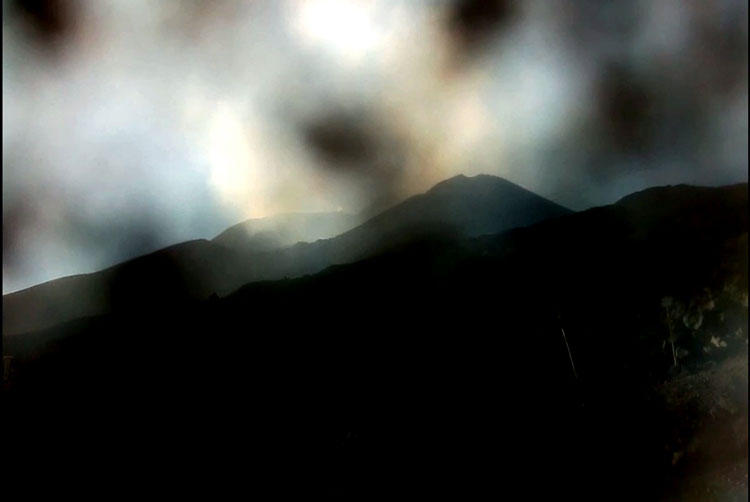
Sarah Wood, Renaissance. Still from Here is Elsewhere, 2020. © Sarah Wood.
by EMILY SPICER
In March this year, the world ground to a sudden halt. Our capital cities fell eerily silent, the skies emptied, the streets stilled and everything changed. This global pandemic is an epoch-defining moment and our response to it was at first unknowable, and then, in many ways, unexpected. But this strange new world is fertile territory for the artist Sarah Wood (b1967, London), who explores the relationship between the individual and historic events. Through her video essays, she has examined migration, revolution and war.
Her latest film, Here Is Elsewhere, is a musing on lockdown and the impact it has on our conscious and unconscious minds. Using contemporary footage and orphaned images found in archives, Wood examines what it means to live through a pandemic, and how the imposed immobility of lockdown has forced us to travel in our heads. The film, made during the UK’s first lockdown, is showing at Kettle’s Yard in Cambridge, and is accompanied by a second work, The Unmade Film, which leaves the visual aspect to the viewer’s imagination and is a narrated series of scenes projected as text. These scenes were scripted by a variety of artists and writers, including Ali Smith, Lucy Harris, Olivia Laing and Luke Fowler, each providing a single-shot vision of the world at large. Wood spoke to Studio International about her Kettle’s Yard commission, her experience of lockdown and the lessons we can learn for a life post Covid-19.
Emily Spicer: How did you first arrive at the idea for Here Is Elsewhere?
Sarah Wood: When lockdown first started, I was interested in what was happening around the world. I found myself watching time-lapse footage from different cities to think about the strange views they offered – all those emptied streets with the cameras still rolling. I thought it might be important to collect that footage. It’s amazingly cinematic. It’s how, on one level, we all want the world to be framed; we each jostle to take our own photograph of the Eiffel Tower, for instance, without people in the way. But when you actually have it, when you see it, it is so horrific.
That was the starting point. I began by thinking about the history of photography and how, almost two centuries on, we mediate our shared world. I wanted to think about the potential of cinema now to respond to the unprecedented times we’re all living through and ask how it can help shape our shared future.

Sarah Wood, Renaissance. Still from Here is Elsewhere, 2020. © Sarah Wood.
ES: What has been your experience of lockdown?
SW: Horrible! I’ve been shielding, so I’ve been in isolation since March. I think we’re very lucky if we’ve got other people with us, otherwise it’s a very strange experience. When the first lockdown happened, I was moved by how quickly the local neighbourhood kicked in with making a system of care so that we could all look out for each other. It was a revelation – humans are really brilliant when they’re put up against it. That was very moving. And I think we’ve lost that a little bit in the second lockdown, because it’s been a bit confusing and staggered. I think that sense of coming together hasn’t really been there and that’s a shame because it was brilliant.
Of course, another revelation has been how art sustained us through this difficult time. We may be apart physically, but we’re connected through the stories and ideas that all art forms can offer us. With the Kettle’s Yard commission, I wanted to think about the way the imagination works to connect us, to make community. As I live in Cambridge, it was also really lovely to be part of a project that was located in the city in this odd moment, to know that a gallery space existed somewhere across town, and that a film could be installed in it, that a space for thought could exist, however contingent, via art for those who could attend in person.
ES: In Here Is Elsewhere you mention the phenomenon of vivid dreaming and daytime visions under lockdown. Can you tell me about your experience of this?
SW: I think it relates to how our minds work all the time. Our imaginations are always trying to recall memories, to produce visions of things so we can make associations to understand the present moment. I talk about it in the film, about a moment in the first oddness of lockdown when, instead of the street in front of me, I momentarily saw a side street of somewhere else. It was so odd, because I was walking home on the transition day, just before the first lockdown was put in place. There were no traffic sounds, no building sounds, no trains, no people – just birds. There was something uncanny about it. My brain must have raced to understand what was happening.
It’s just what our imaginations do, I think. These are unprecedented times, as Boris Johnson kept saying. None of us can work it out, so our minds are working very hard. Because it’s quiet, because we’re in a strange situation, we’re glimpsing a revelation of the mind – a revelation about how the mind operates all the time.

Sarah Wood, Renaissance. Still from Here is Elsewhere, 2020. © Sarah Wood.
After my strange street vision, I did some research and found that there are a lot of studies in neuroscience into the fact that our minds are always guessing, making predictions from fragments of information that they process every second. To test this out, one research group blocked out sections of photographs and wired up participants’ brains to see how their minds re-routed around the blocks to complete the image. The experiment reveals how our minds work with memory and association to imagine reality.
I wanted to reflect these experiments in the film, to offer, on the one hand, an image enabled by the total vision photographic mediation can offer and, on the other hand, the obfuscated image, so the viewer cannot quite make out what they’re seeing at first glance. I wanted those two framings to be set side by side, so the viewer can feel the shift of focus, can glimpse things, rather than simply see them.
Glimpsing! That’s what we’re doing all the time. We think we have a complete grasp on reality, but, really, we’re just guessing from our glimpses matched with our experience. And at the moment we’re missing everyone else agreeing on what reality is, because we’re not talking to other people in the moment. We’re inhabiting a slightly destabilised universe because of this.
For The Unmade Film, I asked lots of different artists to write down some of the things they saw or glimpsed or dreamed during this time, to create a companion sound piece that goes with the film. It’s moving to hear the world views of different people in what they describe. It’s wonderful to hear how different we all are.

Sarah Wood, Renaissance. Still from Here is Elsewhere, 2020. © Sarah Wood.
ES: Will the pandemic change how you make your work?
SW: It has certainly challenged it. I always try to set up communal situations. Even if I make a film for a cinema, I know there will be an audience. And if I make an installation, I want to make something that can be participatory in some way. I suppose I have done that with this project by sharing the work online and inviting people to participate in The Unmade Film. But that’s not the same as being in a room with other people. It’s been quite a challenge to think how to overcome that and think how, if we’re held apart for much longer, we can create situations that are about participation and collective experience.
Practically, it was a challenge to make this film. It was extraordinarily hard to work with my editor in a different city, but I think it was healthy in a way. It made the process new again; it’s really renewed everything. It has also made me think about how to draw people together after lockdown. At the moment, we all want to watch Netflix, we all want to gather around the warmth of stories. So, I think art is going to be essential in the immediate future, and I hope we value it. It’s why the Steve McQueen films have been brilliant on the BBC. People watch them on a Sunday night and there’s this sense of energy that comes out of them, something about the collective coming together at the same time: art as an event. I feel we’ll be drawn to that when we come back into the world and want mass moments again. You can see that with the Black Lives Matter protests this summer. People genuinely had to protest, that moment had to happen. It revealed the push for us all to be together. It’s just huge in us.
ES: Your work encourages us to pause, to reflect and imagine an alternative vision for the future. What do you think that future will look like and what do you want it to look like?
SW: I suppose I feel as if the world is changing a little bit. For the first time, we’re all doing something at the same time, across the whole planet. Surely that should have connected us as human beings. And, environmentally, we should understand that we are part of something bigger. There’s an opportunity now to go out into the world with wide-open eyes and to embrace it. But I have a feeling that human nature will probably mean that we will be quite scared and that we’ll close down all the more for a little while.
I’ve read a great deal about the history of plagues for this project. It makes me hopeful. After the first plague, we had the Renaissance. Maybe a second Renaissance will come! Maybe not in my lifetime, but there’s a possibility that, in a generation, people will want something new – new thoughts, new spaces.

Sarah Wood, Renaissance. Still from Here is Elsewhere, 2020. © Sarah Wood.
ES: In the film, you talk a lot about the forced stasis of lockdown and how we are travelling in our imaginations instead. But I wonder, is travel in the real world a privilege or a right?
SW: That’s an interesting question. If we think of rights as man-made constructs that we can adapt and change, no one has the right to do anything really, unless we legislate. Travel is only as exciting as it is now because of technology, because of what humans have invented. And privilege is only a product of class and wealth. So, all these things are malleable. I worry that the way we think about movement in these odd terms is simply about whether or not borders should be open or shut. These seem to be the only options in this populism-dominated world, so that the malleability of our notion of movement seems to be heading towards a kind of dead-end lockdown of its own.
But I think that the necessary Covid restrictions on movement have taught us something much more fundamental about the way we need to move as human beings to survive. Migration, movement, journeying, are all so important to us. We feel it in a renewed way because we’ve been told to stay still. It makes me hopeful. Surely our ideas about the bordering of the world have to be humanised, have to be made more fluid and permeable. We have to stop thinking about travel as a luxury and a privilege, and start to think about it as something essential. It just feels to me that this time could teach us that. I don’t go along with it, but the people who are going out to protest, to say that they can’t go through lockdown again, are really recognising something vital that we all need. Everybody needs freedom of movement.
I hope that this time will make us more sympathetic to people who are held in stasis. I’ve worked on commissions about refugees and the asylum process, and you realise that it’s such a mad system, to have people of all ages held for years without any kind of life. Now that we’ve all experienced a glimpse of what that feels like, surely we can’t be that cruel any more. I don’t know whether this kind of stasis will make us kinder to other people, but I hope it will.
• Sarah Wood: Here Is Elsewhere is at Kettle’s Yard, Cambridge, until 24 January 2021.
Click on the pictures below to enlarge